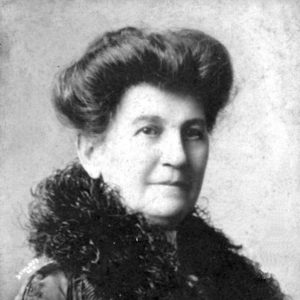calsfoundation@cals.org
Mary Routh McEnery Stuart (1852–1917)
aka: Ruth McEnery Stuart
Mary Routh McEnery Stuart, working under the name Ruth McEnery Stuart, wrote a body of fiction and poetry based on the experiences she had in Arkansas, modeling characters, dialect, and even a fictional town on her interactions within the state. She was, both financially and critically, one of the most successful fiction writers of her time, and in recent years has been studied by feminist and social literary critics.
Routh McEnery was born on February 19, 1852, (according to the date provided on her marriage license; though she may have been born as early as 1849). Her parents were Mary Routh Stirling and James McEnery, who was at that time the mayor of Marksville, Louisiana, where McEnery was born. In addition to their farming interests in central Louisiana, the McEnery family was prominent in Louisiana politics. Some time before 1860, the family moved to New Orleans, where McEnery’s father was employed at the U.S. Customs House. She attended schools there, grew up as an “American”—a native speaker of English and an Episcopalian—in the culturally diverse and racially mixed Louisiana atmosphere that colors many of her stories.
McEnery taught at the Loquet-LeRoy Institute, a sort of finishing school for young women in New Orleans. When she was twenty-seven (or thirty), she married Alfred Oden Stuart, a widower with eleven children, on August 6, 1879. The couple lived in Washington (Hempstead County), where A. O. Stuart had farm property and was a partner in the mercantile establishment of Stuart and Holman. Stuart was well liked in Washington for her hospitality; she organized the Dear Old Town Club and sponsored social gatherings and a book club.
Stuart’s husband died in 1883, a few months after the birth of their son Stirling. She returned with her baby to her family home in New Orleans and began to support herself as a writer. Her first story, “Uncle Mingo’s Speculations,” was published in February 1888 in New Princeton Review. “Lamentations of Jeremiah Johnson” followed in May 1888 in Harper’s New Monthly Magazine. On the basis of these early successes, she moved to New York. She also discarded the family spelling of her name for the more familiar “Ruth.”
In 1893, Harper and Brothers published A Golden Wedding and Other Tales, a collection of eleven of her short stories and two poems. “The Woman’s Exchange of Simpkinsville,” a story in that collection, is set in an imaginary Arkansas town modeled after Washington. The success of this story led her to include some of its characters in her later Arkansas fiction. She became associated with the “Harper set” of writers published by that magazine and, in the early 1890s, occasionally serving as a temporary editor for Harper’s.
Between 1888 and 1917, Stuart published more than seventy-five stories, in addition to dialect verse. These works appeared in major magazines of the day, including Harper’s Bazaar, Harper’s New Monthly Magazine, Century Magazine, New Princeton Review, Delineator, The Outlook, and Lippincott’s Magazine. They were collected in twenty-three volumes. These include A Golden Wedding and Other Tales (1893), Carlotta’s Intended and Other Tales (1894); Solomon Crow’s Christmas Pockets and Other Tales (copyright 1896), In Simpkinsville: Character Tales (1897), Napoleon Jackson, the Gentleman of the Plush Rocker (1902), The Second Wooing of Salina Sue, and Other Stories (copyright 1898), Aunt Amity’s Silver Wedding, and Other Stories (1909), The Unlived Life of Little Mary Ellen (copyright 1910), and Daddy Do-Funny’s Wisdom Jingles (1913). In 1983, the University of Arkansas Press published a collection, Simpkinsville and Vicinity: Arkansas Stories of Ruth McEnery Stuart.
In academic terms, Stuart belongs to the school of American local color writing that emphasizes regional characteristics in landscape, way of life, and language. Her works draw on three main threads of her experience: the white “plain folk” of Washington, the immigrants and aristocrats of New Orleans, and African Americans in the South. Stuart’s stories provide details of the natural and man-made environment, cultural, religious, and family values, and, most noticeably, the idiosyncrasies of the Southern regional dialect. Farmers and their wives, elderly spinsters, country doctors, preachers, and storekeepers reside in her imaginary Simpkinsville. Deuteronomy Jones, who narrates several of the stories, is a farmer who lives in town, and the hero of “An Arkansas Prophet” is a “queer, half-luney” black man. “Queen o’ Sheba’s Triumph” is about a black woman who leaves Arkansas to start a new life in New York. The black characters in her stories are treated sympathetically. While they often have the stereotypical traits of loyalty, good humor, and love of their own and their white “families,” many of these black characters are complex and even mysterious. Though present-day sensibilities shrink from her presentation of “darkies,” “Uncles,” and long-suffering “mammies,” contemporary critics acclaimed her as providing an authentic representation of African Americans.
Stuart also developed a reputation as a platform entertainer and traveled widely in the United States. Some of her works were apparently written for oral presentation, such as the 1898 collection Moriah’s Mourning and Other Half-Hour Sketches. She was also known in England, where she became a member of the Lyceum Club in 1904.
After her only child died in a fall in 1905, Stuart lost some creative momentum. Recurrent bouts of illness and a change in literary fashion diminished her literary output, but she continued to give readings and to travel. In 1915, Tulane University in New Orleans awarded her an honorary degree of Doctor of Letters. Stuart died in New York on May 16, 1917, and she is buried in New Orleans.
The elements that made Stuart a popular writer in her lifetime diminished her appeal to later readers. They saw her as sentimental and condescending in her treatment of African Americans and women. However, in the latter decades of the twentieth century, women’s studies have brought Stuart back into the curriculum, if not the canon, of American literature, giving her credit for her strong female characters, her sympathetic humor, and her skillful use of irony. This revisionist criticism has seen nuances of feminist qualities in some of Stuart’s female characters as they overcome such trials as widowhood, poverty, and disappointed hopes, or subvert the narrow religious and social mores of their culture.
For additional information:
Fletcher, Mary Frances. “A Biographical and Critical Study of Ruth McEnery Stuart.” PhD diss., Louisiana State University, 1955.
Stuart, Ruth McEnery. Simpkinsville and Vicinity: Arkansas Stories of Ruth McEnery Stuart. Edited by Ethel C. Simpson. Fayetteville: University of Arkansas Press, 1983. Reprinted with a slightly revised introduction, 1999.
Reynolds, Claire E. “Speaking Out: Class, Race, and Gender in the Writings of Ruth McEnery Stuart, Edith Summers Kelly, and Harriette Simpson Arnow.” PhD diss., University of Rhode Island, 2008.
Taylor, Helen. Gender, Race, and Region in the Writings of Grace King, Ruth McEnery Stuart, and Kate Chopin. Baton Rouge: Louisiana State University Press, 1989.
Ethel C. Simpson
University of Arkansas, Fayetteville
This entry, originally published in Arkansas Biography: A Collection of Notable Lives, appears in the CALS Encyclopedia of Arkansas in an altered form. Arkansas Biography is available from the University of Arkansas Press.
 Arts, Culture, and Entertainment
Arts, Culture, and Entertainment Literature and Authors
Literature and Authors Post-Reconstruction through the Gilded Age, 1875 through 1900
Post-Reconstruction through the Gilded Age, 1875 through 1900 Ruth Stuart
Ruth Stuart 




Comments
No comments on this entry yet.